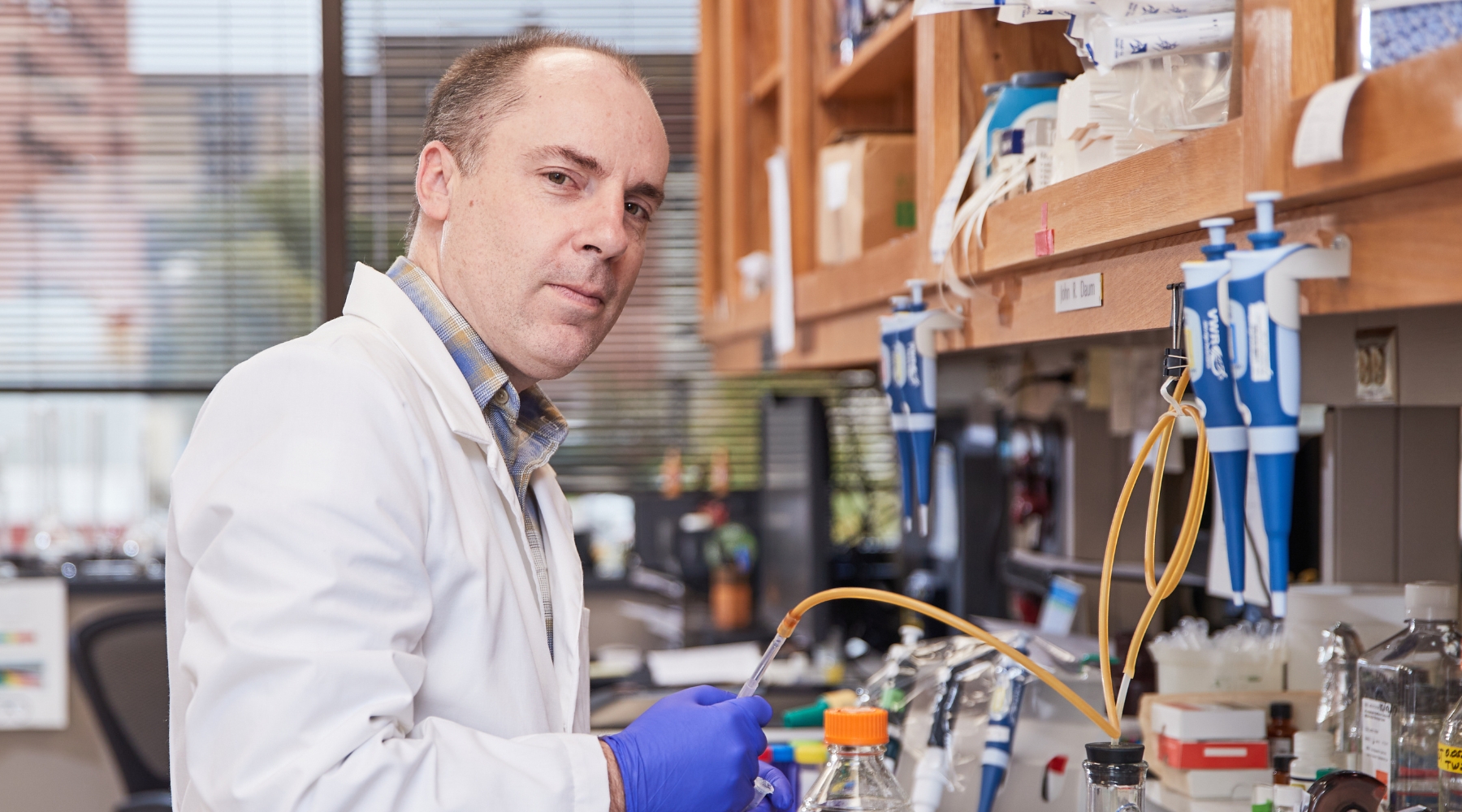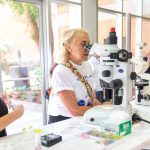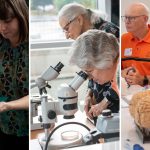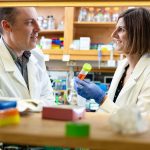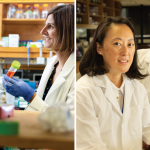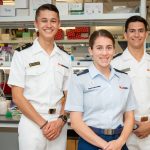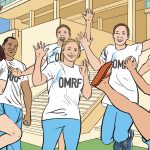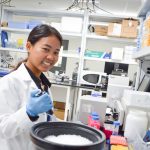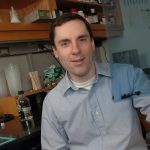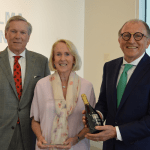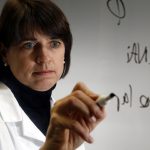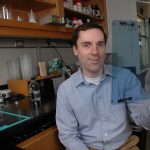Christopher L. Sansam, Ph.D.
Associate Professor
Cell Cycle & Cancer Biology Research Program
My 101
The human body is composed of billions of cells, yet every one of us begins as just a single cell. This means that countless cell divisions occur during a human lifetime. Each cell carries the full set of genes from mom and dad, so every time a cell divides, the genome must be accurately and completely duplicated. We call the process of duplicating genes during cell division "DNA replication."
When considering how many cell divisions occur in each of us and how complicated the process of DNA replication must be, it is not surprising that mistakes during DNA replication cause birth defects and cancer. Despite its fundamental importance for all life, we still know little about how DNA replication is controlled in humans. The Sansam laboratory is identifying the genes, molecules, and mechanisms that are needed to replicate our DNA. We expect that such knowledge will provide a clearer understanding of how a wide range of human diseases occur and ultimately will lead to the development of better treatments for diseases such as cancer.
Lucky for us, DNA replication is so important that even very simple organisms share most of the genes and mechanisms involved with humans. In fact, scientists continue to shed light on how human DNA replication occurs by studying single-cell organisms such as yeast. Of course our genomes are more complicated than yeast, and not surprisingly, humans and other vertebrates have a more elaborate mechanisms for regulating DNA replication. The Sansam laboratory uses two experimental systems to shed light on the process of DNA replication in humans and vertebrate animals. First, to directly study how DNA replication is generally replicated in people, we use human cells dividing in culture. Second, to understand how DNA replication is regulated during the multitude of cell divisions that occur in the developing embryo, we use a simple vertebrate animal called the zebrafish. The zebrafish is the preeminent "model" organism for studying vertebrate embryonic development because it has a complex genome like humans, shares most genes with people, and is highly accessible for observation and manipulation. Using human cell culture and zebrafish, we can understand the genes and fundamental principles of DNA replication both at the single cell level as well as in the context of a real embryo.
Research
My laboratory is interested in how the human genome is replicated. Every time one of our cells divides, billions of base-pairs must be duplicated in the correct sequence and in coordination with other important processes in the nucleus such as gene expression and DNA repair. To ensure that the genome is completely and accurately duplicated during every round of cell division, our cells use complex regulatory systems that determine when and where different parts of the genome are copied. We are just beginning to understanding the mechanisms of this "replication program," but we already know that deregulation of DNA replication leads to cancer and birth defects. We expect that defining the general principles and specific mechanisms of DNA replication control will ultimately lead to better treatments for a number of different diseases including cancer.
To obtain both mechanistic and in vivo information, we study the DNA replication using cultured human cells and zebrafish embryos. Because the zebrafish embryo develops externally, it provides an outstanding opportunity to understand how the genome is properly replicated during the multitude of cell divisions that must occur during embryogenesis. Furthermore, zebrafish can be used for genetic experiments more easily and quickly than other vertebrates. We are currently studying how the DNA replication program adapts to the vast array of cellular changes that occur during embryonic development. We are also delineating the basic mechanisms of DNA replication control. We are studying a number of recently discovered DNA replication control genes that are found in all vertebrates, including fish and humans. We are particularly focused on a DNA replication control gene called TICRR, which we discovered through a genetic screen in zebrafish. This gene is of particular interest because we have shown that it is a pivotal component of the system that determines when and where DNA replication initiates throughout the genome.
Brief CV
Education
B.S., James Madison University, Harrisonburg, VA, summa cum laude, 1997
Ph.D., Vanderbilt University School of Medicine, Nashville, TN, 2004
Postdoc, Laboratories of Nancy Hopkins and Jacqueline Lees, Massachusetts Institute of Technology, 2010
Honors and Awards
Outstanding Student Award, Integrated Science and Technology Program, James Madison University, 1997
Dan May Summer Research Scholarship in Cardiology, Vanderbilt University, 1997
Harold Sterling Vanderbilt Graduate Scholarship, 1997-2004
NIH Ruth L. Kirschstein Predoctoral National Research Service Award, 2001-2004
Anna Fuller Postdoctoral Fellowship, 2004
NIH Ruth L. Kirschstein Postdoctoral National Research Service Award NIH/NIGMS, 2004-2010
Memberships
Sigma Xi
Joined OMRF scientific staff in 2010
Publications
Recent Publications
Noble TD, Sansam CG, Wittig KA, Majchrzycka B, Sansam CL. Cell cycle-dependent TICRR/TRESLIN and MTBP chromatin binding mechanisms and patterns. Genome Biol 26:194, 2025 July, PMID: 40624716, PMCID: PMC12235874
Sansam CG, Masser EA, Goins D, Sansam CL. Due-B Is dispensable for early development and genome duplication in vertebrates. bioRxiv, 2025 June, PMID: 40667299, PMCID: PMC12262730
Hossain MS, Sansam CG, Wittig KA, Noble TD, Boyd KA, Sansam CL. Dynamic regulation of origin firing factors links CDK activity to dormant origin activation. bioRxiv, 2025 June, PMID: 40661636, PMCID: PMC12259077
Selected Publications
Sansam CG, Goins D, Siefert JC, Clowdus EA, Sansam CL. Cyclin-dependent kinase regulates the length of S phase through TICRR/TRESLIN phosphorylation. Genes Dev. 2015 Mar 1;29(5):555-66. PMID: 25737283 PMCID: PMC4358407
Sansam CL, Cruz NM, Danielian PS, Amsterdam A, Lau ML, Hopkins N, Lees JA. A vertebrate gene, ticrr, is an essential checkpoint and replication regulator. Genes Dev. 2010 Jan 15;24(2):183-94. PMID: 20080954 PMCID: PMC2807353
Feng Y, Sansam CL, Singh M, Emeson RB. Altered RNA editing in mice lacking ADAR2 autoregulation. Mol Cell Biol. 2006 Jan;26(2):480-8. PMID: 16382140 PMCID: PMC1346902
Dawson TR, Sansam CL, Emeson RB. Structure and sequence determinants required for the RNA editing of ADAR2 substrates. J Biol Chem. 2004 Feb 6;279(6):4941-51. PMID: 14660658
Sansam CL, Wells KS, Emeson RB. Modulation of RNA editing by functional nucleolar sequestration of ADAR2. Proc Natl Acad Sci USA. 2003 Nov 25;100(24):14018-23. PMID: 14612560 PMCID: PMC283538
Contact
Cell Cycle & Cancer Biology Research Program, MS 48
Oklahoma Medical Research Foundation
825 N.E. 13th Street
Oklahoma City, OK 73104
Phone: (405) 271-7677
Fax: (405) 271-3045
E-mail: Chris-Sansam@omrf.org
For media inquiries, please contact OMRF’s Office of Public Affairs at news@omrf.org.
Lab Staff
Kevin Boyd
Senior Bioinformatics Analyst
Krishanu Dhar
Graduate Student
Tyler Noble
Graduate Student
Jase Daugherty
Administrative Assistant III
Denna Mills
Administrative Assistant III
News from the Sansam lab
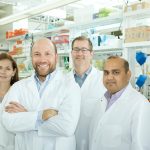
Scientific excellence requires a host of ingredients: dedication, attention to detail, resilience, innovation. Each of these, in turn, relies on having a staff that’s both talented and committed to solving difficult problems. In other words, says OMRF President Dr. Steve Prescott, “The key is people. They have to believe in the scientific mission of the […]
